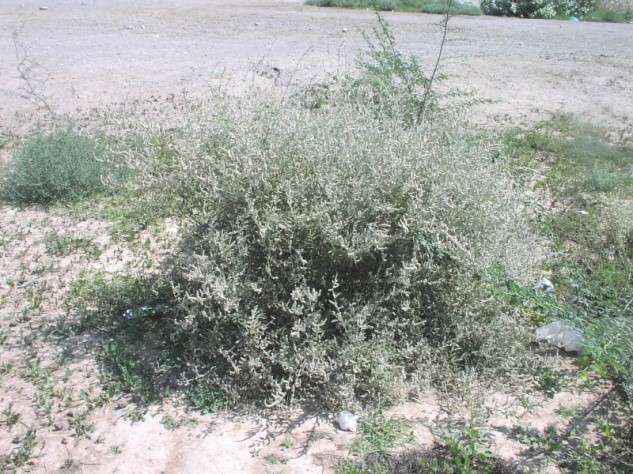
Aerva javanica / الآرا
Achyranthes javanica (Burm. f.) Pers. Aerva persica (Burk. f.) Merrill Aerva tomentosa Forssk. , Aerva wallichii Moq. Celosia lanata L., Illecebrum javanicum (Burm. f.) Murr. Iresine javanica Burm. f., Iresine persica Burm. f.
Al ara’, Trif, Yar, Shajarat Alghazaal, Shajarat Alnaaja, Kharetaan, Um Sharaya, Arwa, Baroo
Java aerva, Aerva, Desert Cotton, Kapok Bush, Snow Bus
Al ara’, Raa,
Amaranthaceae
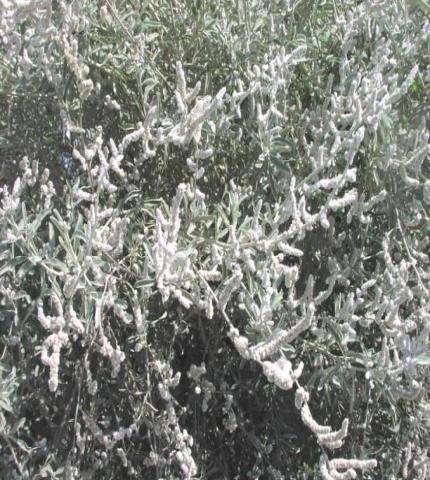
Aerial parts
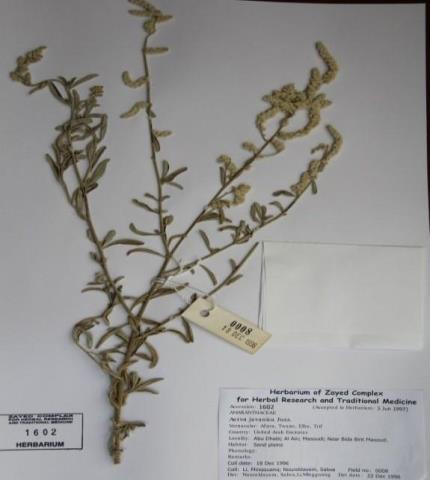
Herbarium specimen
Ethnobotanical Characteristics
Description
Perennial straggly bush, frequently woody growing in erect clumps, 0.3-1.5 m, branched from about the base with simple stems or stems with long, ascending, sometimes intricate branches. Stem and branches terete, striate, ± densely whitish- or yellowish-tomentose or pannose, when dense the indumentums often appearing tufted. Leaves alternate, very variable in size and form, from narrowly linear to sub orbicular, ± densely whitish- or yellowish tomentose but usually more thinly so and greener on the upper surface, margins plane or more or less involute (when strongly so the leaves frequently ± falcate-recurved), sessile or with a short and indistinct petiole or the latter rarely to c. 2 cm in robust plants. Flowers dioecious. Spikes sessile, cylindrical, dense and stout (up to c. 10 x 1 cm.), to slender and interrupted with lateral globose clusters of flowers and with some spikes apparently pedunculate by branch reduction; male plants always with more slender spikes (but plants with slender spikes may not be male); upper part of stem and branches leafless, the upper spikes thus forming terminal panicles; bracts 0.75-2.25 mm, broadly deltoid-ovate, hyaline, acute or obtuse with the obscure midrib ceasing below the apex, densely lanate throughout or only about the base or apex, persistent; bracteoles similar, also persistent. Female flowers with outer 2 tepals 2-3 mm, oblong-obovate to obovate-spathulate, lanate, acute to obtuse or apiculate at the tip, the yellowish midrib ceasing well below the apex; inner 3 slightly shorter, elliptic-oblong, ± densely lanate, acute, with a narrow green vitta along the midrib, which extends for about two-thirds the length of each tepal; style slender, distinct, with the two filiform, flexuose stigmas at least equaling it in length; filaments reduced, anthers absent. Male flowers smaller, the outer Whole Plant Aerial parts tepals 1.5-2.25 mm, ovate; filaments delicate, the anthers about equaling the perianth; ovary small, style very short, stigma rudimentary. Capsule 1-1. 5 mm, rotund, compressed. Seed 0.9-1.25 mm, round, slightly compressed, brown or black, shining and smooth or very faintly reticulate (Jongbloed et al. 2003; Fawzi, 1995; Mandaville, 1990; El-Ghonemy, 1993; Western, 1989, eFloras).
Habitat and Distribution
It has a native distribution ranges from Northern Africa to southwestern regions of Asia, and throughout Arabia and in the drier parts of the tropics and subtropics. Grows in disturbed and irrigated places. Commonly found on roadsides and in stony and gravelly wadis and hill slopes. The plant is wide spread in UAE especially in the Northern Emirates, where it is found on roadsides, disturbed sites; silt in rocky wadis and on alluvial plains.
Part(s) Used
Whole plant
Traditional and Medicinal Uses
The plant is used by traditional medicine practitioners for the treatment of kidney stones, inflammation, skin infection, toothache, headache and abdominal worms. The flowers are used for the treatment of wounds by mixing with water to form a paste which is used as wound dressing and to stop bleeding. Fumigant of the whole plant used as an aphrodisiac (Al-Yayha, 1990; El-Ghonemy, 1993).
Pharmacognosy and Phytochemistry
Plant material Studied
1.) Dried leaf with occasional floral spikes
General appearance
The leaf is light grayish green in color in the upper surface while the lower surface has a silvery grey color and a woolly touch. It is brittle and when dried, it curls inwards exposing the lower epidermis outwards. Leaves vary in length (15-40 mm) and they are about 5mm broad. They are usually mixed with spikes of white flowers having a very light weight.
Microscopical characteristics
The leaf is unilateral, where a layer of the palisade tissues underlain by a layer of palisade tissues underlines the upper epidermis only (not the lower epidermis). In regards to the surface view, the upper epidermal cells are shown to have sinuous (wavy) cell walls. The epidermis bears many characteristic covering trichomes - including peculiar branching in trichomes as the major ones - in addition to occasional curved simple covering trichomes each with about three basal cells and a tapering end. The palisade cells are oblong with thin cell walls and wide lumens, and some of them contain calcium oxalate prisms. The spongy mesophyll cells are polygonal in shape and a part of them contains single large cluster crystals of calcium oxalate, while those surrounding the vascular tissues are quite characteristic as they appear as a circle of polygonal cells with thick cell walls. The lower epidermis consists of relatively small cells but it bears numerous different covering trichomes especially the branched ones. Stomata are found on both epidermises and they are oval and anomocytic.
2.) Dried stem and branches
General appearance
The stem and branches have a light grayish green color; they are cylindrical in outline and have a slight coarse touch. The branches are slender and are 1-2 mm in diameters. They are brittle and when cut, they show dark-colored internal tissues. A cross section of the stem shows its cylindrical outline. The epidermis consists of anticlinal oblong cells which bear many peculiar branched covering trichomes as those borne on the leaf, in addition to few simple conical ones. The epidermis is underlain by few layers of collapsed parenchyma cells with thick cell walls, and some of these contain brown pigments. The cortex is composed of parenchyma cells which are nearly rounded. The outermost cortical layers enclose a layer of interrupted groups of lignified fibers, where each fiber is divided into compartments with thick walls and wide lumens. The cortical endodermis is not well defined. On the other hand, the vascular tissues are heavily lignified and they include large vessels with wide lumens. The pith occupies a wide central zone and it consists of large characteristic polygonal cells with thick pitted (perforated) cell walls.
3.) Powdered plant material
The materials consist of the pounded aerial parts. It is a light hairy, raw-cotton-like white powder with a yellowish tint. It has an odour reminiscent of dried straw and an almost flat taste but with a very slight bitterness. Microscopically, the powder shows numerous long intermingling covering trichomes with several short sharp side protrusions together with stellate trichomes. Fragments of the green leaves are very rich in translucent rosettes of calcium oxalate, which are almost circular in outline. Calyx or corolla parts have characteristic long narrow cells with conspicuous cell walls.
Parts studied: leaves and stem
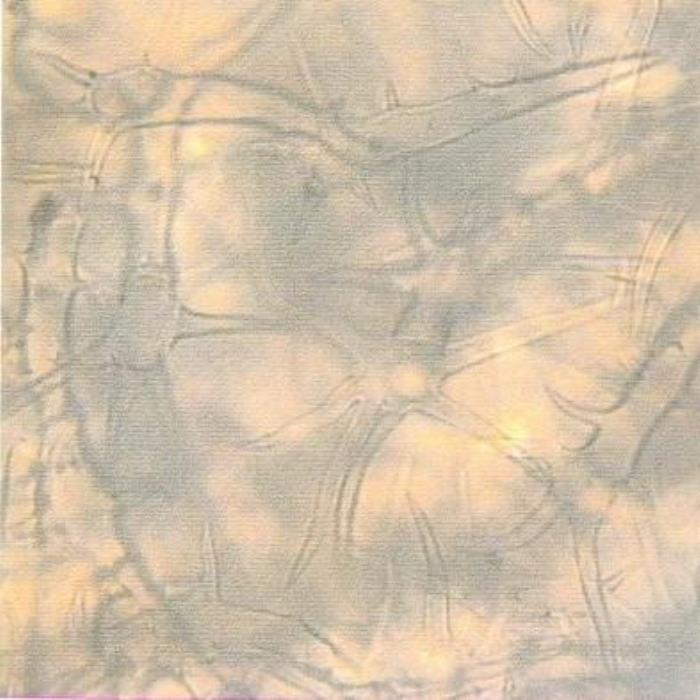
A) T S of leaf
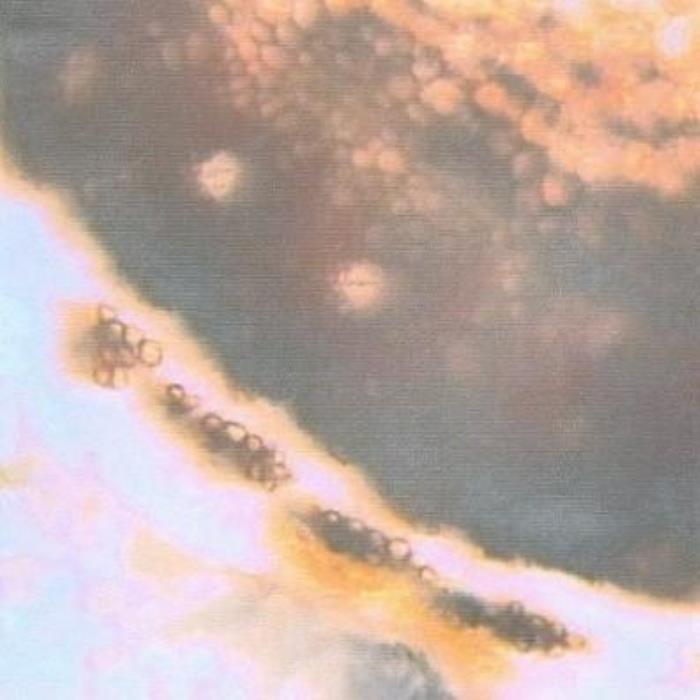
B) T S of stem
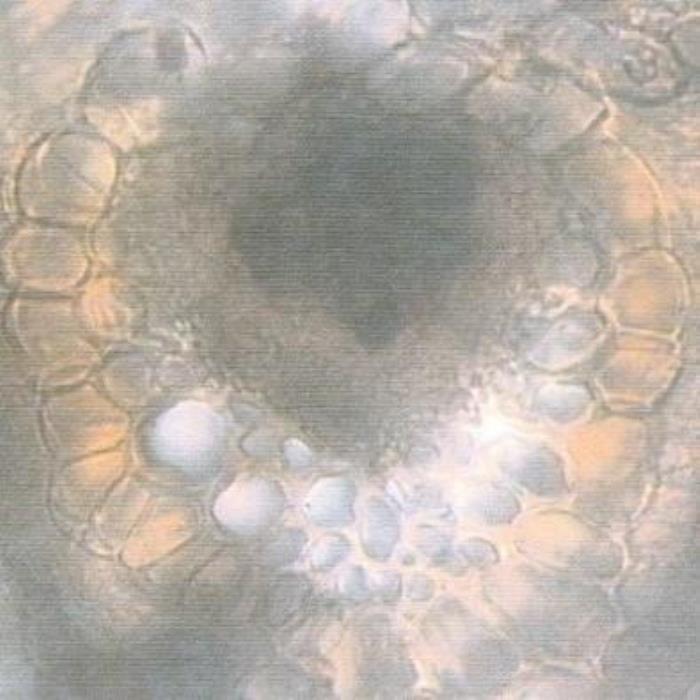
C) Vascular tissues
- A.TS of the leaf showing the upper epidermis with borne covering trichomes, palisade layer, and the characteristic polygonal cells that form a circle around the vascular tissues besides a spongy mesophyll cell that contains a large cluster crystal of calcium oxalate.
- B. TS of stem showing the heavily lignified vascular tissues including few large xylem tracheids and many vessels (dark violet red); also shown is a group of parenchymatous cells with thick pitted cell walls (light pink in color).
- C. A layer of fibers at the periphery separated from both epidermis and vascular tissues by a layer of parenchyma cells. The vascular tissues are heavily lignified. Circular lacunas are also observed within the vascular tissues (stem).
Chemical constituents
The presence of steroids (Usmanghani, 1982), triterpenoids (Radwan, 1999), carbohydrates (Emam, 1999), flavonoids (Saleh, 1990), and saponin content (Ammar, 1998) have been reported. Flavanol:Isorhamnetin-3-O-β-[4´´´-p-coumaroyl-α-rhamnosyl(1→6) galactoside] (Nabiel,1990).Isorhamnetin-3-O-[4-o-p-coumaroyl-a-L-rhamnopyranosyl-(1→6-β-D-galactopyranoside] (John Buckingham,1995). Coumarins, sterols, triterpenes (El-Ghonemy ,1993). The leaves contain hentriacontane, nonacosane, nonacosanol, tritriacontane, tetratriacontane, β-sitosterol (and its glucoside), and oleanolic acid, several glycosides of kaempferol and Alkaloids (Ghazanfar, 1994). β-Sitosterol, α-amyrin, palmitic, stearic, linoleic, myristic, palmitoleic, oleic acids, β-Sitosterolglucoside and oleanolic acid; kaempferol-3-galactoside and kaempferol-3-rhamnogalactosid, hentriacontane, nonacosane, nonacosanol, tritriacontane, tetratriacontane, Flavanone (aervanone) and kaempferol-3-O-β- [4´´´-p-coumaroyl-α-rhamnosyl (1→6) galactoside] (Rastogi, 1991,1993,1998). Flavanone: (Persinol) and flavanone glucosides: (persinosides A and B) (Ahmed, 2006). Coumarono chromone analogue: Aervins A, B, C and D (Imran, 2009).
The following chemical studies have been carried out on the aerial part of the plant Aerva javanica (Quality Control methods, 1998; Evans, 1996, ZCHRTM unpublished work).
Physicochemical constants
Loss of weight on drying at 105°C: 8.10
Absolute alcohol solubility: 4.00
Water solubility: 16.40
Successive extractives (%)
Petroleum ether (60-80) °C : 1.50
Chloroform : 1.40
Absolute alcohol : 7.50
pH values (aqueous solution)
pH of 1% solution : 6.716
pH of 10% solution : 6.419
Ash values (%)
Total ash : 11.50-13.35
Water soluble ash : 4.80
Acid insoluble ash (10% HCl) : 0.62-1.10
Elemental analyses
Ash values (British Herbal Pharmacopeia)
Assay and identification of elements (AOAC International)
|
Apparatus |
(AA-6800 Shimadzu-Flame method) |
||||
|
Element |
Std. conc. μg/ml(ppm) |
Sample conc.mg/ml |
Samples absorbance |
Actual conc.mg/ml |
Actual conc. (%) |
|
Cr |
1, 2, 4 |
39.992 |
0.0018 |
0.00666 |
0.000666 |
|
Zn |
0.5, 1, 2 |
39.992 |
0.2735 |
0.03660482 |
0.00366048 |
|
Cu |
0.5, 1, 2 |
39.992 |
0.0542 |
0.0182586 |
0.0018258 |
|
Fe |
1, 2, 4 |
39.992 |
0.5998 |
0.7564912 |
0.075649 |
|
K |
1, 2, 4 |
39.992 |
2.0196 |
0.6457816 |
0.0643781 |
|
Pb |
1, 2, 4 |
39.992 |
0.000 |
0.000 |
0.000 |
|
Cd |
0.25, 0.5, 1 |
39.992 |
0.000 |
0.000 |
0.000 |
UV Spectral studies
|
Sample conc. (mg / ml) |
Solvent |
λ max (nm) |
λ min (nm) |
Abs. ( λ maxλ min) |
|
0.92 |
Intestinal Fluid simulated without pancreatic pH = 7.5±0.1 |
271 |
240 |
0.684 |
|
1.04 |
Gastric Fluid simulated without pepsin pH =1.2±0.1 |
268 |
250 |
0.878 |
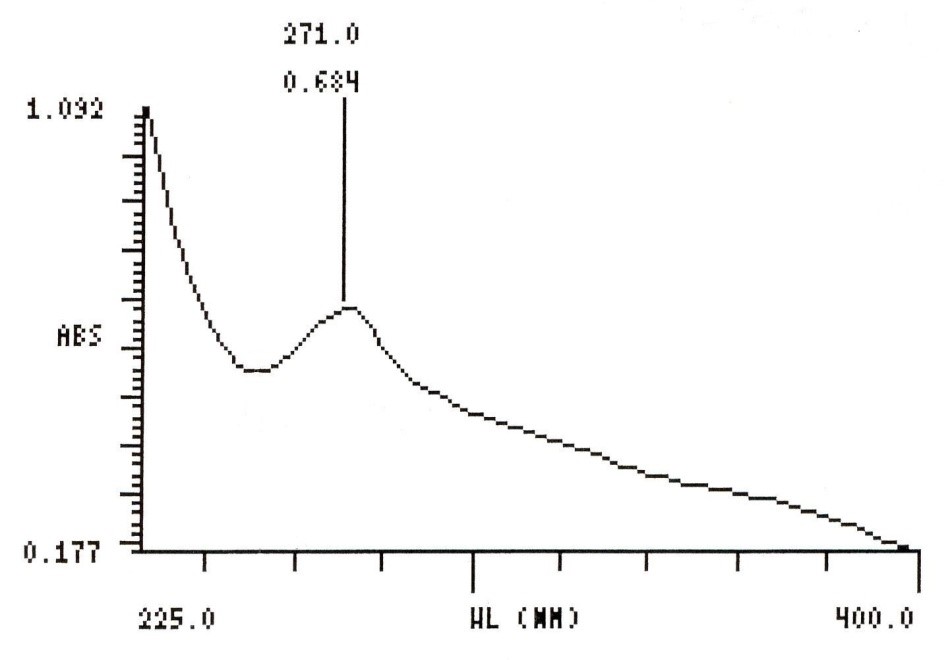
Intestinal Fluid simulated without pancreatic
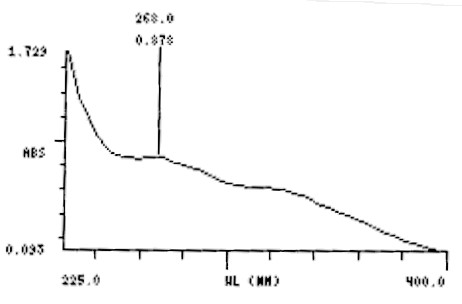
Gastric Fluid simulated without pepsin
Chromatographic Studies
Thin layer chromatography (Wagner and Bladt, 1996)

A

B

C

D
TLC fingerprint of Pet. ether (60-80) °C extract (track 1) and MeOH extract (track 2)
|
Mobile phase Fig. |
A&D |
: |
Toluene, ethyl acetate (93:7) |
|
|
B |
: |
Toluene, ethyl formate, formic acid (5:4:1)) |
|
|
C |
: |
Ethyl acetate, methanol, water (100:13.5:10) |
|
Detection |
A |
: |
UV 366nm |
|
|
B&C |
: |
UV 254nm |
|
Derivatization |
D |
: |
Vanillin-Sulphuric acid- vis. |
Pharmacological &Toxicological Studies
1.) Ethanol extract 70%
Methanolic extract of Aerva javanica leaves has been tested for C.N.S. depressant activity (Srinivas, 2009). The plant has also been reported to have analgesic and anti-inflammatory activity (Reddy, et al., 2009). Administration of plant extract of the leaves were shown in different doses and in alloxan treated mice (70 mg/kg, i.e.) showed antihyperglycemic activity (Srinivas, 2009).
Aerva javanica has been reported to show a significant antihyperglycemic activity justifying its use in traditional system of medicine (Srinivas, 2009). Aerva javanica is reported to inhibit the spontaneous activity in guinea-pig colon and rabbit jejunum, antihistaminic and antinicotinic activities on guinea-pig ileum (Khare, 2007). It has been reported (bet-abisobolol) as sedative and carminative. The leaves are used in early stage of diarrhea and dysentery (Rhamatullah, 2009). Fifteen biological trace elements essential to plants, man and animals (silver, gold, cobalt, copper, chromium, nickel, lead, iron, magnesium, manganese, potassium, sodium, strontium, zinc and calcium) were estimated and analyzed including Aerva javanica which has been given uses as therapeutic agents for humans and in the treatment of mineral deficiency in animals (Rashed, 1995).
The following pharmacological and safety evaluation studies were carried out on the plant extract of Aerva javanica (Derelanko 2002; Han, 2003):
|
ACTIVITY |
RESULTS |
|||
|
Strong |
Moderate |
Mild |
Negative |
|
|
Antidiabetic |
✅ |
|
|
|
|
Analgesic |
|
|
✅ |
|
|
Antidepressant |
|
|
|
✅ |
|
Anti-gastric ulcer activity |
✅ |
|
|
|
|
Anticonvulsant |
|
|
|
✅ |
|
Effect on rabbit jejunum |
|
✅ |
|
|
|
Effect on rat fundus |
|
✅ |
|
|
|
Effect on Guinea pig ileum |
|
✅ |
|
|
|
Effect on right rat atria |
|
✅ |
|
|
|
Antithrombotic effect |
✅ |
|
|
|
|
Diuretic effect |
|
|
|
✅ |
|
Studies on biochemical parameters |
|
|
✅ |
|
|
Studies on hematological parameters |
|
|
|
✅ |
|
Effect on onset and duration of pentobarbitone sleeping |
|
|
✅ |
|
|
Motor co-ordination (grip strength & motor activity |
|
|
|
✅ |
|
Rectal temperature |
|
|
|
✅ |
|
Body weight |
|
|
|
✅ |
|
Vital organs |
|
|
|
✅ |
|
Mortality |
|
|
|
✅ |
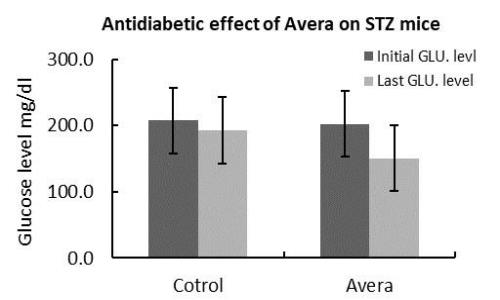
Antidiabetic effect of Avera javanica on STZ treated mice
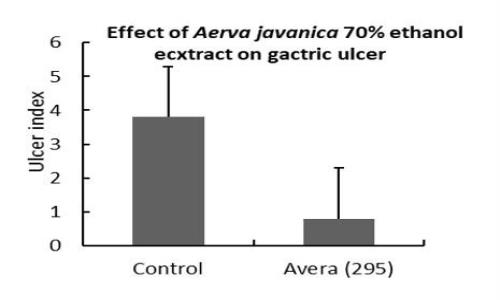
Effect of Aerva javanica 70 % ethanol extract on gastric ulcer
Summary of the results
The present study showed that the oral administration of the plant extract possesses potent anti-hyperglycemic, mild analgesic, mild antidepressant activities. The plant-based drug at the dose of 1g/kg, p.o., showed strong gastro-protective activity in mice; relieved gastrointestinal spasm and improved digestion. The plant extract was tested for Adaptogenic activity showed anti-stress activity. The plant extracts showed positive inotropic property (cardiotonic effect); and significantly prolonged the bleeding time. Administration at the dose of 1 g/kg b.w. daily, for 15 days (in which serum biochemical serum changes were quantified) showed no change in hematological parameters when compared to control.
The plant extract did not cause abnormal symptoms or death to animals in the acute toxicity (the LD50 >10g/kg, p.o.). The plant extract was tested for repeated dose toxicity and showed no noticeable toxicity signs and symptoms in the treated animals at the dose of 2 g/kg, p.o. daily for ten days. No significant change in vital organs weights (liver, spleen, kidney, uterus, ovaries and testes) were recorded.
Antimicrobial activity
The aqueous extract of the whole plant was tested against Mycobacterium smegmatis, Candida tropicalis, different strains of Methicillin Resistant Staphylococcus aureus, different strains of ESBL-producing K. pneumonia, E. coli, Pseudomonas aeruginosa and showed no inhibition of growth.
References
- Ahmed E, Imran M, Malik A, Ashraf M., Antioxidant activity with flavonoidal constituents from Aerva persica. Arch Pharm Res. 2006 May;29(5):343-7.
- Al-Yayha, M. A., Al-Mesha, I. A., Mossa, J. S., Al-Badr, A. A. & Tariq, M. (1990) Saudi Plants A Phytochemical and Biological Approach. King Abdul Aziz City for Science & Technology,Riydh, Saudi Arabia.
- El-Ghonemy, A. A. (1993). Encyclopedia of Medicinal plants of the United Emirates. 1st Edition. University of U.A.E.
- El-Ghonemy, A. A. Encyclopedia of Medicinal Plants of the United Arab Emirates. (1993)1st Edition, University of U.A.E.
- Fawzi, M. K. (1995). Weeds in the United Arab Emirates. University of U.A.E.
- Flora of Pakistan; www.efloras.org
- Ghazanfar S A. Handbook of Arabian Medicinal Plants, CRC Press, 1994.
- Imran M, Ibrahim M, Riaz N, Malik A. Structure determination of Aervins A-D, new coumaronochromone analogues from Aerva persica, by 1D and 2D NMR spectroscopy. Magn Reson Chem. 2009 Jun;47(6):532-6.
- John Buckingham (Editor) , Dictionary of Natural Products, Volume 7, Chapman& Hall/CRC,England.1995.
- Jonbloed, M. V., Feulner, G. R., Boer, B. & Western, A. R. (2003). The comprehensive Guide to the Wild Flowers of the United Arab Emirates, Erwda, Abu Dhabi, U.A.E.
- Khere, C P. Indian Medicinal Plants. An Illustrated Dictionary, Springer, USA. 2007.
- Mandaville, J. P. (1990). Flora of Eastern Saudi Arabia. Kegan Paul international ltd. England.
- Nabiel A. M. Saleh, Ragaa M. A. Mansour and Kenneth R. Markham. An acylated isorhamnetin glycoside from Aerva javanica . . Phytochemistry , Volume 29, Issue 4 , 1990, Pages 1344- 345.
- Rahmatullah Q. and Bhatti U. Folklore uses of Amaranthaceae family from, Pakistan. Pak. J. Bot, 2009, 4: 1565-1572.
- Rashed, M N. Trace elements in some wild plants from the shores of the high dam lake and the adjacent desert, as determined by atomic absorption spectroscopy, Journal of Arid Environments, 1995, 2:185-197.
- Rastogi & Mehrotra, Compendium of Indian medicinal plants : vol. 2, PID, New Delhi,1991,p.18.
- Rastogi & Mehrotra, Compendium of Indian medicinal plants : vol. 3, PID, New Delhi,1993, p.18.
- Rastogi & Mehrotra, Compendium of Indian medicinal plants : vol. 5, PID, New Delhi,1998, p.19.
- Reddy K S, Srisailam K, Reddy V M. Analgesic and anti-inflammatory activity of various extracts of leaves of Aerva javanica, Advances in Pharmacology and Toxicology, 2009, 2: 11-17.
- Srinivas K R. Antihyperglycemic activity of ethanol extract of Aerva javanica leaves in alloxan- induced diabetic mice. Journal of Pharmacy Research, 2009, 7.
- Srinivas K R and V.M. V M. Pharmacological evaluation of methanolic extract of Aerva Javanica leaves for Central Nervous System depressant activity. The Pharmacist, 2009, 1.
- Usmanghani K, Nazir M. Chemical constituents of Aerva javanica, Fitoterapia. 1982, 3: 75-77.
- Western, A. R. (1989). The Flora of United Arab Emirates. An introduction. Publications of the U.A.E. University.
